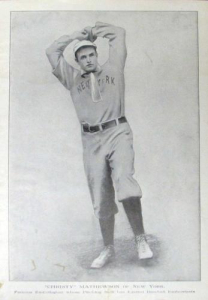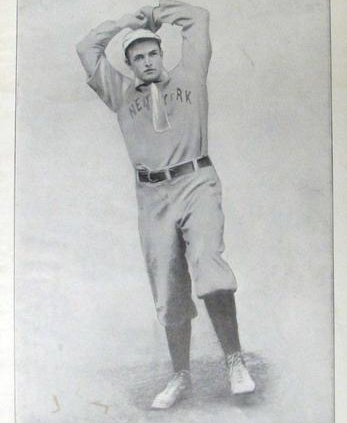July 15, 1901: Christy Mathewson pitches no-hitter as Giants avoid sweep in St. Louis
 For many baseball fans, 1901 marks the beginning of the “modern” era.1 That year saw the arrival of the eight-team American League to go with the recently realigned eight teams of the National League, and a stability that lasted for over 50 years.2
For many baseball fans, 1901 marks the beginning of the “modern” era.1 That year saw the arrival of the eight-team American League to go with the recently realigned eight teams of the National League, and a stability that lasted for over 50 years.2
It also marked the emergence of one of the greatest pitchers in the history of the game. Of course, 20-year-old Christy Mathewson had to earn his way to stardom in coming years, but he started making his reputation when he became a regular for the New York Giants at the beginning of the 1901 season.
Mathewson had appeared in six games in the prior season, beginning with his debut on July 17, 1900. In what amounted to his rookie season of 1901, he pitched well – and often – to begin the campaign. Matty, as he came to be known, already had a 12-6 record when the Giants began a Western road trip – Pittsburgh, Cincinnati, and St. Louis – with a July 4 doubleheader against the National League-leading Pittsburgh Pirates, then with a one-game lead over the second-place Giants. Mathewson pitched 12 innings in a complete-game victory for New York in the opener. Four days later, Mathewson pitched the Giants to a 9-3 victory over the Cincinnati Reds.
Arriving in St. Louis for a critical four-game series on July 12, with the Giants now third behind the Pirates and St. Louis Cardinals, Mathewson dropped a 3-2 decision to the Cardinals, losing on an unearned run in the bottom of the 11th inning.3 Mathewson’s record then stood at 14-7, with four of his seven losses coming against St. Louis.
The Giants lost the next two games to St. Louis, giving them eight losses in 10 games. With New York trying to stay in the NL race, manager George Davis called on Mathewson again to start against the Cardinals on July 15 with only two days’ rest.
The short rest (even by 1901 standards) did not trouble Mathewson as he tossed the NL’s first no-hitter of the Modern Era to lead the Giants to a 5-0 victory over St. Louis.4 The effort was also the first-ever no-hitter at League Park, also known as Robison Field.5
New York gave Mathewson all the runs he needed by scoring twice in the first inning and twice in the second against Cardinals pitcher Willie Sudhoff.6 The Sporting News suggested that Sudhoff “started so poorly that a victory for St. Louis was well-nigh hopeless” from the beginning.7 The Giants collected 10 hits, all singles, off Sudhoff in the game.
Center fielder George Van Haltren had two hits and two RBIs, and Davis – who played third while managing the Giants – had one hit, a sacrifice, and two RBIs. New York shortstop Charlie Hickman added two hits and a run batted in. Left fielder Kip Selbach and second baseman Sammy Strang each had two hits.
Taking a 2-0 lead to the mound in the bottom of the first, Mathewson yielded a leadoff walk to left fielder Jesse Burkett, who was headed for his third career batting title in 1901, but Burkett was retired trying to steal second. Right fielder Patsy Donovan, a .301 hitter in 17 big-league seasons, was out on a liner back to Mathewson, and first baseman Pop Schriver popped up to his Giants counterpart John Ganzel to end the inning.
New York was ahead 4-0 when Matty started the second inning with another walk, this time to second baseman Dick Padden. Then the Giants quickly retired shortstop Bobby Wallace on a pop foul and got third baseman Otto Krueger and catcher Jack Ryan on groundballs.
From that point on, Mathewson was in complete control against a St. Louis team that led the NL with an average of 5.6 runs per game in 1901. After the walk to Padden in the second, 17 Giants were retired in a row, including all four of Mathewson’s strikeouts in the game. The streak ended when, with two out in the seventh, Padden again drew a walk, but Wallace followed with a groundout to second to end the inning.
St. Louis’s only runner in scoring position of the day came with one out in the eighth when “Van Haltren, after a long run for Ryan’s fly, dropped the ball and Ryan wound up at second” on the error. Cardinals center fielder Art Nichols moved Ryan to third on a groundout, but pitcher Sudhoff “knocked a liner into Mathewson’s hand and killed St. Louis’s only chance.”8
New York added one more run in the ninth inning to make it 5-0. With only three outs to go to complete the masterpiece, Mathewson needed a little help as Burkett hit a low liner to left field leading off the inning. Selbach made fine running catch of the ball, a play the New York Times labeled as “unexpected and a feature of the game.”9
Donovan followed with a fly out to center. Matty issued his fourth walk of the day, this time to Schriver, but Padden’s grounder resulted in a force out on Schriver at second, and an end to Mathewson’s superb effort.
Nearing the end of the game, Mathewson was loudly cheered by the local fans, according to press reports. “The crowd, contrary to its usual habit when a game is as good as over, remained to the last act of the last inning to see Mathewson complete his non-hit performance,” the St. Louis Post-Dispatch observed. “The local enthusiasts have a liking for the young New Yorker and were almost glad to see the Giants win on his account, that is, if the frequent expressions of encouragement and approval are considered.”10
The 1901 Giants had little team success after Mathewson’s July 15 gem. They lost 56 of their final 75 games to come in at 52-85, in seventh place in the NL, 37 games behind the pennant-winning Pirates.
Still, Mathewson finished the season with a record of 20-17 over his 40 starts. He hurled 336 innings and finished with a 2.41 ERA. It was clearly a sign of things to come. Manager John McGraw joined the Giants in 1902, marking the beginning of greatness for the Giants and Mathewson in the first part of the twentieth century. Mathewson went on to win 372 games with New York through 1916; the Giants won five pennants and the 1905 World Series during his tenure.11
Author’s note
Newspaper coverage of the game in the New York Times, New-York Tribune, and St. Louis Post-Dispatch did not contain detailed descriptions of how the Giants scored their runs.
Acknowledgments
This article was fact-checked by Jim Sweetman and copy-edited by Len Levin.
Sources
In addition to the sources cited in the Notes, the author consulted Baseball-Reference.com and Retrosheet.org for pertinent information, including the box score.
https://www.baseball-reference.com/boxes/SLN/SLN190107150.shtml
https://www.retrosheet.org/boxesetc/1901/B07150SLN1901.htm
Notes
1 No exact date seems to define the beginning of baseball’s modern era. Dr. Harold and Dorothy Seymour use 1903 as the start of The Golden Age to separate it from The Early Years. They wrote about the peace brought about by the creation of the National Commission, the beginning of the World Series, and the relative stability of baseball in the years that followed. Harold and Dorothy Seymour, Baseball: The Golden Age (New York: Oxford University Press, 1971), vii. Bill James notes that “clean baseball arrived in 1901 with the emergence of the American League.” Additionally, a major rule change delineated pre- and post-1901 records. The National League adopted the foul as a strike rule in 1901. Said James, “[T]he foul strike rule was probably the major defining force of the decade. Prior to 1901, a foul ball was not a strike. The American League adopted the same rule in 1903. Bill James, The New Bill James Historical Baseball Abstract (New York: The Free Press, 2001), 71-72. The foul strike rule change shifted the balance of power to the pitcher and the “1900s were the heyday of dead ball.” David Nemec and Saul Wisnia, 100 Years of Major League Baseball (Lincolnwood, Illinois: Publications International Ltd. 2000), 10.
2 The AL had two franchise shifts in its early years, when the Milwaukee Brewers became the St. Louis Browns after the 1901 season and the New York Highlanders replaced the Baltimore Orioles in 1903, but otherwise the AL and NL kept 16 teams in the same cities until the Boston Braves relocated to Milwaukee after the 1952 season.
3 “New York Loses to St. Louis in Eleven Innings,” New-York Tribune, July 13, 1901: 11.
4 “Pitcher Mathewson’s Work Kept Giants from Losing World Beating Games,” St. Louis Post-Dispatch, July 16, 1901: 6. The most recent NL no-hitter was by Frank “Noodles” Hahn on July 12, 1900, as he led Cincinnati to a 4-0 win over Philadelphia. Baseball-Reference.com and Retrosheet.org credit Pete Dowling of the Cleveland Blues with pitching the first AL no-hitter on June 30, 1901, 15 days before Mathewson’s gem in St. Louis.
5 The Sporting News, July 20, 1901: 4.
6 St. Louis Post-Dispatch, July 16, 1901: 6.
7 The Sporting News, July 20, 1901: 4.
8 “New York, Aided by Mathewson’s Excellent Pitching, Won from St. Louis,” New York Times, July 16, 1901: 5.
9 “New York, Aided by Mathewson’s Excellent Pitching, Won from St. Louis.”
10 St. Louis Post-Dispatch, July 16, 1901: 6.
11 Mathewson pitched one more no-hitter during his legendary 17-season career, on June 13, 1905, against the Chicago Cubs. He won 31 games in 1905 and led the majors with a 1.28 ERA, as the Giants won their second pennant in two seasons and New York’s first championship of the “modern” NL-AL World Series.
Additional Stats
New York Giants 5
St. Louis Cardinals 0
Robison Field
St. Louis, MO
Box Score + PBP:
Corrections? Additions?
If you can help us improve this game story, contact us.


